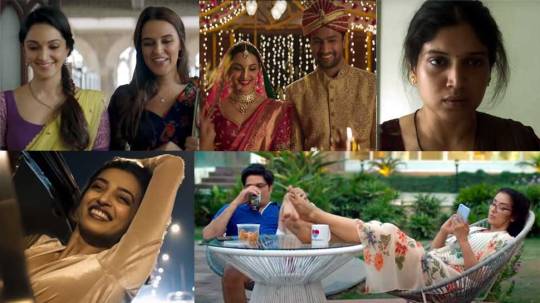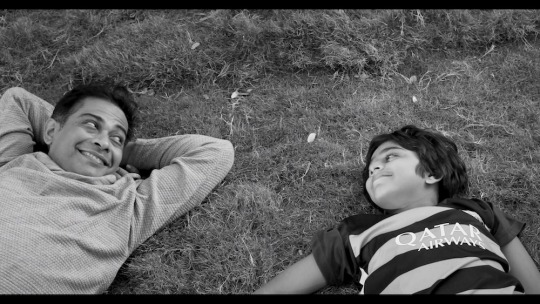Text
Lust Stories - mature and not frivolous

Image source: www.fg.com
An anthology of films about lust out of South Asia would surprise many, but they are definitely long overdue. Before delving into the specifics of each film, something that applies to all four is that sex and lust aren’t dealt with the usual strokes of skin, amateur depictions of sex and sexuality. Instead, all four films speak (not always successfully) to the core of the human experience and intimate relationships in general. I’ll leave my favourite film for last, while the other three I will speak about without an order of preference.
Anurag Kashyap’s film is the most erratic of the group. An erratic narrative can be well crafted, if it doesn’t fall into the trap of repetition and characters lacking an arc. The protagonist is a young professional (college teacher), who decides to sleep with one of her students. After the night is done, she puts the guy on notice that he should not think much of what happened and her only real fear is that he might get emotional and attached, given the fact that it was his first time being with a woman. The setup is interesting, even the fact that the woman is calling the shots, but then the narrative takes a nosedive. Radhika Apte playing the college teacher Kalindi tries quite unsuccessfully to steer clear of coming across as over the top and purposelessly dramatic. Kalindi becomes excessively possessive of the young man; while she doesn't want to commit to anything with him, but constantly calls him out on his relationships and the women he is dating. There is also a lot of time spent with Kalindi sitting in front of the camera. She tries to speak to the problems of contemporary relationships, the emotional entanglements that come with, but most of that is rambling. I really didn’t care much about the narrative after the first ten odd minutes and the thirty plus minute length of the film is just painfully long.
Karan Johar’s film about a newly married couple, where the husband is unable to comprehend his wife’s needs at intimacy is funny, with Neha Dhupia playing this small but incredibly brilliant character. She is a divorcee but refuses to be judged and lives her sexuality on her own terms. She takes sexual power by the horns and snatches it away for herself. She is empowering through and through. While not the protagonist, she was truly the highlight of the film. The couple’s story (played by Kaira Advani and Vicky Kaushal) which has spurts of entertainment and their attempted reconciliation to solve their marital problems, against all social and family odds is overall charming and leaves you feeling heartened.
Dibanker Banerjee's film had a sense of maturity about it, given the subject matter, however I found it quite tedious. I get the principle: unhappy couple, tied together because of financial and social factors, wife is cheating on the husband with the best friend, but it's mostly a been their seen that kinda narrative. While heavyweights like Sanjay Kapoor, Manisha Koirala and Jaideep Ahlawat add some heft to the film, overall it was underdeveloped both in terms of characters and narrative. The film leaves us without a resolution, which perhaps is closer to how life is, but felt quite unsatisfying.
My favorite film was Zoya Akhtar’s beautifully crafted story about a forbidden relationship, entangled with social and economic disparities and their naked severity. Bhumi Padnekar’s restrained performance spoke volumes of how pervasive our social hierarchies are. Zoya knew that a social commentary about sex and lust would be brilliantly represented through the prism of economic differences and she drove the message home in a poetically subtle manner, free of any histrionics.
While all of the films differed in narrative quality and what they were able to achieve, it’s no mean feat to put together an anthology like this that primarily speaks about women and their quiet fight for equality, in being able to express their sexuality. I appreciated the maturity with which all subjects were tackled and the purposeful avoidance of frivolous and stereotypical depictions of sex and lust.
The choice to release the films on Netflix as an anthology was interesting. I hope people far and wide get to watch, what surely in an interesting/welcome change for South Asian cinema. Lust Stories is now on Netflix.
#lust stories#shorts#southasiancinema#storiesaboutsex#sexandlust#women'schoice#woman'srighttochoose#anthologies
2 notes
·
View notes
Text
We all know we wanted love !

Source: slashfilm.com
Coming of age and coming out stories have been done from different points of view. But this one decides to go back to the roots. Let's talk about a love story and well in this case a twist in a typical high school romance. Simon (played with a lot of heart and soul by actor Nick Robinson) is closeted and lives the ‘normal’ life of a teenager. He is popular in school, has a great group of friends and is far from being an outcast. It's interesting that if this film were made even a decade ago, the idea of coming out would have been so much more dramatic. Also, given the white picket fence suburban life of Simon’s family, (Josh Duhamel and Jennifer Garner play the picture-perfect parents), this is really an idealistic world presented to us. But the lack of drama doesn’t really take away from the story.
There is no dramatic moment and a collection of small, touching spurts, but connecting with Simon, like anyone who sought to fall in love, is easy and seamless. Simon begins to live out his secret life, when someone from school comes out anonymously on the school’s social networking platform. Simon immediately reaches out to them (under a pseudonym, which sets a chain of sharing, (semi)romantic emails and what Simon sees as a budding relationship. There is even some poetry in this as the anonymous boy at school signs off as Blue, and Simon begins to fall for Blue over the course of his emails.
Love is obviously never easy and someone from school chances upon Simon’s emails on a public computer at the library. Blackmail ensues, Logan Miller playing Martin Addison wants in on Simon’s friend Abby (Alexandra Shipp) and wants him to help and woo her. All of this horribly goes wrong after a string of lies places Simon at odds with all of his friends.
The strength of the film is that it doesn’t pretend to be more than it is. It is a high school romance and coming out story of a young boy looking to fall in love. While the narrative lacks nuance and texture, it has some sweet comic moments and strong performances by a string of actors Simon (Robinson), Abby (Shipp), Keiynan Lonsdale (playing Simon’s friend Bram), and Katherine Langford as Leah, who hopes for more than just a friendship with Simon.
Love, Simon takes you on a romantic ride of Simon wanting to find out Blue’s real identity, a little segway mid film of his parent’s acceptance of his sexual orientation and the realization that we all wanted to fall in love when we were young (and after of course). The film even differentiates how the two parents react differently to their son’s sexual orientation; attempts at keeping the story authentic.
I liked the film for its spirity representation of teenage love, the trails of wanting to be in love, without it being overly dramatic, which tends of happen with stories about adults in similar situations.
2 notes
·
View notes
Text
From Padmavati to Padmaavat
Disclaimer: I grew up watching Bhansali’s Khamoshi, Black and Hum Dil De Chuke Sanam and obviously I love him for his opulence, his grandeur and the visual treat that he offers his audience. There is an excess that should be nauseating, yet it is decadent, that’s what I love about Bhansali.
Over the years my politics has taken me further away from his interpretations, however my senses still thrive being fed his imagery. I don’t want to get into a whole lot of what has already been said about his new film (or the politics of meaningless protest by the Karni Sena). As a critique of the film, I’d like to offer something that sticks to the merits of the film. I want to focus on Padmaavat (the erstwhile queen Padmavati) as a piece of cinema.
Bhansali does justice to the two major plot lines of the film, as he sets up the Khilji rule, led by the majestic Raza Murad (playing Jalaluddin Khilji) and Ranveer Singh as Alauddin Khilji). Alauddin is flamboyant, perhaps spoilt and unabashedly ambitious. He stands firm in Jalaluddin’s aura.
On the other side is the Rajput kingdom of Rawal Ratan Singh (actor Shahid Kapoor), who discovers Padmavati (Deepika Padukone) while hunting in the forest. The early romance is sweet, tender and a bit reminiscent of a 1950s period piece. And Bhansali does it purposely, for he will juxtapose the sweet tender romance of Rawal Ratan and Padmavati to the jealous cravings of Alauddin Khilji.This is all for dramatic effect, as he will reveal over the next 150 minutes.
The Khiljis engage in expansion, intrigue, power at the cost of all else. While the Rajputs do that too, to a certain extent, but Bhansali chooses not to explore that. He will only go as far and give us a taste of the palace intrigue on the Rajput side, when Rawal Ratan’s Rajguru (political mentor) is introduced to Padmavati. The short discourse between them was the best set of dialogues in the close to three-hour long saga. But with the Rajguru’s banishment, all intrigue, political frolic and the story comes to a complete halt. It becomes a predictable dramatic one twist to the other from here on. We know that the Rajguru will go and form an alliance with Khilji, who in turn will train his eyes on Rawal Ratan’s kingdom and Padmavati. This will eventually end in the Rajputs and the Khiljis coming face to face. The end.
Now let’s look at the rest of the film. Visually this is stunning and we wouldn’t expect anything but from Bhansali. Each and every frame is painstakingly crafted. From the palace of the Khiljis, the spaces that the characters inhabit, the fortress/city of Rawal Ratan and Padmavati and everywhere where the camera even glances at, is Mughal-E-Azam all over again. All credit to the cinematographer (Sudeep Chatterjee) and the art directors who help bring Bhansali’s vision to life.

image courtesy: india.com
The characters: For all the criticism that Bhansali has received for presenting Alauddin Khilji’s character as barbaric, lustful and treacherously ferocious, I found Khilji’s character the only one who really gets any attention from Bhansali’s pen. He is crafted with range, substance and yes he is vile. As an antagonist, in typical Bollywood/drama/fiction style, he has to be vile and eccentric. Does this make Bhansali anti-Muslim? Did I respond to Khilji and think all Muslims are like that? I equally enjoyed his exchanges with his court poet Khusru. And while I will call Bhansali out on his depiction of Malik Kafur (played by Jim Sarbh: the brilliant star of the film) for playing into the Bollywood stereotype of LGBTQ characters on screen, I do give him and Ranveer Singh credit for exploring ‘bisexuality’ in a mainstream Bollywood film. Malik Kafur’s character falters towards the end, but he comes to the audience in spurts and he is just wonderful. And for whatever it's worth, the Khilji-Kafur interaction was way more interesting than anything Padmavati and Rawal Ratan’s characters had to offer. It was rather hilarious and in a way Bhansali indulging in self-deprecation, when Khilji mocks Rawal Ratan for being oh so saintly and good.
Padukone as Padmavati should have been the heart of the film, but she isn't. Bhansali played with the idea of turning Padmavati into the astute, politically savvy protagonist that she could have been. But instead he chose to leave her out completely in the first half, so that whole thing came to naught. And by the time she is back, you have been blinded and exhausted by the colors and cravings of Bhansali’s canvas.
I want to be more generous to Kapoor for playing Rawal Ratan with some stoic restraint, but I can only compliment him for his chiseled torso, unfortunately. I kept hoping that his first wife Nagmati (played by Anupriya Goenka) would come out of the shadows, but again Bhansali decided character development didn’t matter in a magnum opus.
The practise of Jauhar: Jauhar was a prevalent practise in the Rajput communities for centuries. I saw the depiction as merely a recreation of a practise that existed in medieval India. I asked people in my entourage and no one seemed inspired to commit Jauhar after watching the film, as was being suggested by commentators, social media folk. From where I sat, Bhansali’s depiction of Jauhur (unlike Sati) was similar to say Ridley Scott’s depiction of Maximus as a Gladiator. Archaic and dehumanizing, of course, but not glorified. It’s part of the poem (Padmavat, 1540) that Malik Muhammad Jayasi wrote and the film being inspired from it, saw it make its way as a dramatic, over the top climax.
My critique of the film is that Bhansali lost an opportunity to really tell an intriguing, layered, engaging story about a character who is part of contemporary folklore, something that is naturally expected of him. His journey from Padmavati to Padmaavat meant that we were given a visual treat, which besides Ghoomar (a song I absolutely love) was lacklustre musically and absent a whole narrative. I momentarily pondered over the alleged nexus between the Hindu-right and Bhansali for creating a propaganda piece furthering the Hindu-Rajput identity, but then I remembered that the chest thumping of Rajput pride is just part of how Bollywood films approach religion and the Rajput/Hindu confluence. So, I won’t blame Bhansali for being at the root of the problem, he is merely a symptom.
3 notes
·
View notes
Photo

#shaimykitty #shaishai #chinkyu #loss #death #cycleoflife #mylove #alwaysinourheart #suchagoodkitty #lifeandeath #lovemycats (at Montreal, Quebec)
#mylove#death#lifeandeath#cycleoflife#loss#shaimykitty#alwaysinourheart#lovemycats#shaishai#suchagoodkitty#chinkyu
0 notes
Text
120 beats per minute – human experience in action
Any social movement goes through phases of trials and tribulations. In the 21st century and now in 2017, while a postal ballot is looking to facilitate gay marriage in a country, we have really traversed a long path to our fight for LGBTQ+ rights. And it goes without saying that the battles are far from having been won.
The time wasn’t long ago when the basic right to accessing lifesaving medication was no small challenge. The governments of the world were pretty much hell-bent on denying people rights to basic medicine, but more than that the epidemic that was staring everyone in the face was being treated like a plague that would consume only a ‘certain’ section of the populace. And the world seemed ok with that idea. Men having sex with men was such an abhorrent idea for the mainstream, that if they were being wiped away by a new illness, then they called for it. I am hopeful that in the spirit of our evolving societies, a majority of the world doesn't share these sentiments anymore.

image source: traileraddict.com
120 Beats per minute (original french: 120 battement par minute), is such a pertinent film in furtherance of a historical discourse around the LGBTQ movement. We meet our protagonists in the late 1980s in France, where a sociological battle is raging in the streets. Sick folk are hanging on to the last bits of hope that any of them have, and a group of fired up activists are meeting ever so often to keep the government and the pharma giants on their toes; not letting up on their dual fight for survival.
While the film is rich in characters and we meet quite a few interesting shades of people, the main story is centred around the slowly developing romance between the two protagonists. Sean has been suffering from HIV, when he was infected by a teacher at the age of 16. Nahuel Biscayart plays Sean Dalmazo, a firebrand member of the group, who never hesitates to speak his mind and while projects a spirit of self-assured confidence, shrivels up as a vulnerable human as he tries to persevere through a very emotional journey. Biscayart brings strength, vulnerability coupled with an endearing quality to Sean. He is soft, feisty and driven by fairness throughout. It has been one of the finest performances I have seen in 2017.
His love interest is the handsome Nathan (Arnaud Valois) who is the shy, soft spoken pragmatist, but instantly smitten by Sean. His negative status also adds an interesting texture to his character and interaction with Sean. The film presents a charged world of progressively worsening health status of HIV infected people, fighting the powerful levers of the state, that is denying them trails, information and are hand in glove with pharma companies.
Nathan and Sean present the perfect mesh of pragmatism and agressive activism, when faced with a towering challenge of changing laws and mindsets. The film naturally veers towards tragedy, as Sean’s condition begins to worsen, while his resolve to continue to fight, both for the cause and his life doesn’t waiver.
120 Beats Per Minute is a very affecting film, that at the heart of it speaks to mistreatment of humans, by their fellow humans, even in times of great adversity. More than anything the film spoke to me of the absurdity of human behaviour, but only realized in hindsight.
Filmmaker Robin Campillo has created a film that is rooted in historical facts, but does not pretend to be a documentary. The romance and the emotional suffering is not pretentious and certainly not dramatic; something a film like this could have easily veered towards.
Kudos to Campillo who was able to raise close to 5 million dollars to make the film in a few months and then bring to life a portrait of rare human experience in action.
120 Beats Per Minute is my favorite film of 2017.
#120 beats per minute#120 battements par minute#filmmaking#activism#lgbtq rights#aids epidemic#struggle never ends
0 notes
Photo

#shokolade #zürich #dayoutwithfamily #café #walkingtours nothing like when you are told ‘no hot chocolate to go’ #sitdown #justbe (at Zürich, Switzerland)
0 notes
Photo

#zurich #zurichspots #cityscape #walkingtour #overcastday #almostwinter ended the walking tour with a coffee and #swissgipfeli (at Zürich, Switzerland)
0 notes
Photo

#outfortheday #pigeonphotographer #selfie #poses #pigeons #capturingmoments #cityscape #friendship
0 notes
Photo

#friendsforever #birthdays #memories #food #ami(e)s (at MESA 14)
0 notes
Text
A Billion Colour Story

image source: thamarai.com
Filmmaker Padmakumar Narasimhamurthy is a self-proclaimed poet and through his first foray into feature filmmaking, we see the strokes of his poetry and lyrics, as they gently guide this beautifully humane tale towards its idealistic sunset in the horizon. In a world that is steeped in strife and difference, perhaps you don’t need loud, boastful or even argumentative rhetoric to make a point. And what is the point? .. that we should all respect other humans and not judge or be hateful based on primarily human made differences of religion, ethnicity, social status and the like? I know that’s a little too simplistic, but that’s the simple and lyrical A Billion Colour Story.
Set on the colorful (the film is all in black and white) canvas of what is contemporary India: from its festivals, to the music, the food, the Diwali sweets and the lights that scatter throughout the length of breadth of it's bustling cities, towns and villages, A Billion Colour Story is life in contemporary India seen through the world of an idealistic, agnostic, man Imran Aziz (actor Gaurav Sharma), born in a Muslim Family. He is brilliantly supported by his Hindu wife Parvathi (actor Vasuki Sunkavalli) and their eleven-year-old son Hari Aziz (brilliantly played with Dhruva Padmakumar), whose voice over brings comfort and maturity throughout the narrative. Imran and Parvathi are filmmakers/screenwriters, who came back to India after having studied in Australia for a few years, where they met. The two marry and we meet them, as they are in the thick of making a movie. Their religious background is important, as the film speaks to the absurdity that is religious/communal strife. Narasimhamurthy smartly makes us privy to the two protagonists’ religious leanings (lack thereof), making their suffering even more ridiculous.
The financing for their film is somewhat rocky and they are not sure if they’ll be able to finish it. Before things can improve, they start to get worse. They have to sell their home to pour money into the movie. This sets them on an apartment search, where they are constantly reminded that they are in a mixed marriage. Growing up in India, I thought inter-caste marriage was a challenge; and while things have gotten better, the perils of ignorance and deeply rooted prejudices make it impossible for inter-religious marriages to escape the ere of one's family, community, society, workspace everyone.
The film attempts to place itself in the constantly deteriorating status of things in India. While most of it has been attributed to the new dispensation, however, I believe that a change in government or the top-down approach may be a catalyst for how things happen, but is never the cause. The hatred that people demonstrate is rooted somewhere in our psyches. The fear of something else, someone else, the “Other” is what plays out in every facet of our lives.
As Imran battles to find a home and find money to make his film, Pravathi continues to be his rock. Parvathi is both serene, resilient and oftentimes the pragmatic one of the two.
Outside of the brilliant performances of the two actors, Hari is the soul of the film. A critical eye may find imperfections, as they exist in everything, but an eleven year old boy’s lens into his parents’ life was sheer genius.
The film asks us these fundamental questions: what kind of world do we want to live in? Do we want to deny people a place to live, hate them just because we don’t agree with them, or they don’t look like us, speak our languages, or whatever other reason of difference we can conjure up?
A Billion Colour Story must be watched for not just its humanity, but the idealistic redemption that Imran undergoes, no matter the extent of his tragedy.
Kudos to the filmmaker, who didn’t just make me cry twice over, but also made me realize that idealism isn’t lost, can’t be lost...or else our existence on this planet would be more directionless than ever.
0 notes
Photo

#accessramp #traintravel #libertyvillage #accessibilityforall #sotoronto #traintravelisthebest (at Liberty Village)
0 notes
Photo

#judicialreview #legalprinciples #lawexams #studentontrain #montrealàtoronto #MTL #TO #immigrantlife (at VIA Rail - Montreal Downtown)
0 notes
Photo

#asseenfromabove #flyingisawesome #humans #stridesofhumanity #imagination #cloudsandsky #blanketoverthecity
#asseenfromabove#cloudsandsky#blanketoverthecity#imagination#humans#stridesofhumanity#flyingisawesome
0 notes
Photo

#nature #lac #stmarguerite #foliage #natureliving #workretreat #life I can live ! (at Club Lac Walfred)
1 note
·
View note
Text
The end of the world….unstoppable..
Aronofsky’s work is not for the impatient, neither does he expect everyone to come on board (even if he is making Noah), but after A Requiem for a Dream, Mother has become my favorite work by the filmmaker. He brings us themes galore: writer’s block, the ever parasitical artist, a poet’s life, masculinity weaved in with patriarchy, existentialism, our degrading mother Earth ravaged by war, climate change and mostly humans. Mother is everything and just a simple statement of fact of who we are as people.
Aronofsky’s protagonist, playing the title role, actor Jennifer Lawrence has a complex role to play. With the burden of the Earth weighing on her shoulders, Lawrence does quite well. I don’t have too many words of critique for her, my only problem with her was repeated emotions. I felt that while she embodied (very effectively for the most part) the grace and the tolerance of Mother Earth, her reprisal of intruders into her home came with monotonic responses and words like ‘leave my home’ and ‘what are you doing here’? I would have expected a bit more range from a protagonist. She welcomes you into her idyllic seeming home with the tranquil warmth of a mid-summer day, but the grass in her meadow grows rowdy pretty quickly and there is an early interruption to her expected picture perfection.
Ed Harris and Michelle Pfeiffer play the perfect intruders. They lead a charge of ‘outsiders’ who come to seek refuge, then take and finally pillage anything and everything they can. It’s not what they do really, but the mere presence of Pfeiffer, who gives Lawrence the stare of death, makes her presence/silence worth a million words. There is death, blood, and mind-numbing violence in the second half, but making Lawrence’s offspring the main- course of a tragic feast, makes Mother veer into gruesome territory. But then such is the feast we perpetually seem invited to, in how we engage with our mother planet…?

image source: splashfilm.com
The allegory that is Mother, is about the bleeding Earth and of the perpetually exploited. The one panting for breath, Mother Earth is both mother and muse, she is both the bearer of life and nurturer. She is also the one that is pillaged. The metaphor though obvious and simple, is told in a complex web of emotional meanderings that evoked feelings from the depth of my memories and psyche.
While Aronofsky’s uses the perfect vehicle to tell a story of such angst, pain through the catalyst of a struggling poet/artist, but when the writer’s block passes, we don’t see or hear a single verse from this poet. I can’t imagine that poetry wouldn’t have added to the violent tragedy that is the human species.
The poet, Javier Bardem, plays the perfect patriarch; the all-consuming artist, the one who puts nothing before his art. He is brooding and generous, he is flippant and intense. While the narrative leans heavily towards Lawrence, Bardem compliments her well and with utmost sincerity. The one scene that will forever stay with me, is when he walks through the burnt down edifice that is humanity, with a charred mother in his arms and she asks him who he is and he casually, as a matter of fact responds ‘I’.
The claustrophobia of the close ups, the few frames of the Gothic mansion and the intricate, pale surroundings that the mother and the poet inhabit, make every frame clings to you like a pastel memory. Mother isn’t just food for thought, it’s meant to be a window into our soul and that of our home, with perhaps the hope of an impossible awakening.
0 notes
Photo

#peoplearepeople #fierté #humans the #samelove #strength #difference #equal #onespecie #oneplanet #pridemontreal2017 (at Montreal, Quebec)
#samelove#difference#strength#onespecie#humans#equal#pridemontreal2017#fierté#peoplearepeople#oneplanet
1 note
·
View note
Photo

#pflagmontréal #fiertécanadamontréal2017 #pride🌈 #pride2017 #communityday #happypride
0 notes